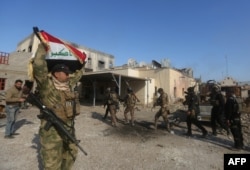Iraqi forces trying to clear Ramadi after seizing the city from Islamic State militants are meeting with heavier resistance than first anticipated.
U.S. military officials initially said “the numbers are small” when asked about how many IS fighters were left in the city after Iraqi forces moved into key areas of Anbar’s provincial capital Monday. On Wednesday, however, officials said Iraqi forces were encountering “pockets of resistance” and sporadic attacks, indicating a larger presence.
“They are still there,” a U.S. official told VOA on condition of anonymity. “They’re expanding their asymmetric tactics to buy more time and space.”
The official would not say how many enemy fighters remained in Ramadi but indicated it was more than the few hundred thought to have been defending the city.
The official also left open the possibility that the number of IS militants could grow as clearing operations closed in on new areas, including some in the north and east of the city, near the Euphrates River.
U.S. officials said they saw Islamic State fighters fleeing to that area, known as the “Shark’s Fin” because of its shape, as those IS fighters sought to get out of the way of Iraqi forces.
At a briefing earlier Wednesday in Baghdad, a coalition intelligence official put the number of fighters at about 700, twice the size of earlier estimates.
"Within what we call central Ramadi, they estimate still up to 400 Daesh [Islamic State] members," said U.S. Army Captain Chance McCraw, according to a report from Reuters. He was using a common Arabic word for IS.
“Once you go east of that towards Fallujah, you've got about 300 out there in that direction,” McCraw added.
WATCH: Related video report by Jeff Seldin
Until Wednesday, U.S. and Iraqi officials had been confident that efforts to encircle the city and cut off access to resupply and reinforcement from other Islamic State units had been taking a heavier toll. Additionally, more than 600 coalition airstrikes were thought to have whittled down the number of IS fighters.
“I think it goes to show how much uncertainty there is about what is occurring on the ground,” said Thomas Joscelyn, a senior fellow at the Foundation for Defense of Democracies, a terrorism research group in Washington.
“The U.S. doesn't really have firm figures for ISIL's forces,” he said, using an acronym for Islamic State. “The ambiguity in Ramadi is a part of a larger problem.”
Many U.S. officials have also been wary of placing too much importance on numbers as an indication of success, with Ramadi being an example.
“We think less about numbers and more about what can they do,” Operation Inherent Resolve spokesman Colonel Steve Warren told Pentagon reporters Tuesday during a teleconference from Baghdad. “We don't think that the remaining enemy has the oomph [strength] to push the Iraqi security forces off of their positions.”
Warren said most of the early counterattacks in Ramadi consisted of small groups of three to five militants using either a heavy machine gun or a rocket-propelled grenade, indicative of what was to come. Many of the buildings have also been rigged with explosives designed to kill and slow down Iraqi forces.
There are also concerns the militants will try to hide among Ramadi’s civilian population.
On Tuesday, the Iraqi military said it had freed 52 families trapped inside Ramadi. Islamic State fighters had been using them as human shields, the officials said.










